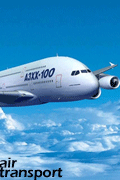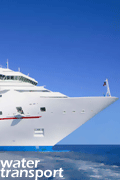Wednesday, January 28, 2009
Wednesday, January 28, 2009 - Average domestic air fares in the third quarter of 2008 reached $362, the highest level of average fares for any quarter in the 13 years measured by available data, the U.S. Department of Transportation's Bureau of Transportation Statistics (BTS) reported today.
BTS, a part of the Research and Innovative Technology Administration, reported that the average domestic itinerary fare in the third quarter was 2.8 percent higher than the $352 average domestic fare in the second quarter of 2008, the previous quarterly high. See http://www.bts.gov/xml/atpi/src/avgfareseries.xml for historic data.
Average domestic air fares in the third quarter of 2008 were up 10.4 percent from the third quarter of 2007 in the largest year-to-year increase since the second quarter of 2006, and average fares increased 7.4 percent above the previous July-to-September high set in 2000. The third-quarter 2008 average fare was up 22.0 percent from the post-9/11 third-quarter low of $297 in 2004.
Average fares increased 25.8 percent from the third quarter of 1995 to the third quarter of 2008 compared to a cumulative 42.8 percent inflation rate. Third quarter 2008 fares increased 10.4 percent from the third quarter of 2007 compared to a 4.9 percent inflation rate.
Average fares are based on domestic itinerary fares, round-trip or one-way for which no return is purchased. Fares include taxes and fees. Averages do not include frequent-flyer or "zero fares" or a few abnormally high reported fares. Average fares in this release may not be comparable to BTS fare press releases before the second quarter of 2007 which did not exclude frequent flyer fares or abnormally high fares. Bulk fares continue to be excluded as in earlier releases.
Spirit Airlines failed to file its report for the third quarter. Data from Spirit for the second quarter of 2008 was not included in this release or the October 2008. Atlantic City, NJ, is not included because Spirit operates more than 90 percent of the flights there. The Atlantic City average fares in the July 23, 2008 press release were based on incorrect data. The data available on the BTS database for the fourth quarter of 2007 and the first quarter of 2008 have been revised to eliminate Spirit's submissions. See http://www.bts.gov/xml/atpi/src/index.xml Spirit has been notified about the incorrect data. The failure to file was referred to the Department's Office of General Counsel for review.
Beginning with the first quarter 2008 release, BTS does not include Alaska, Hawaii and Puerto Rico airports in average fare totals and rankings. Average fares for those airports are available on the BTS Air Fare web page: http://www.bts.gov/xml/atpi/src/index.xml
Of the top 100 airports based on originating passengers, the highest third-quarter average fares were in Cincinnati; followed by Knoxville, TN; Greenville/Spartanburg, SC; Grand Rapids, MI; and Madison, WI. The lowest fares in the top 100 airports were at Dallas Love; followed by Orlando, FL; Burbank, CA; Long Beach, CA; and Islip, NY. See the BTS Air Fare web page for average fares for the top 100 airports.
The largest year-to-year average fare increases for the third quarter among the 100 largest airports, ranked by 2007 originating passengers, was 26.8 percent in Minneapolis/St. Paul; followed by Islip, NY; Chicago Midway; Knoxville, TN; and Columbus, OH.
The biggest year-to-year average decrease was 4.8 percent in Long Beach, CA; followed by Burlington, VT; Salt Lake City, UT; Atlanta; and San Antonio, TX.
The largest average fare increase from the third quarter of 1995 was 212.0 percent at Dallas Love, followed by Lubbock, TX; Colorado Springs, CO; El Paso, TX; and Houston Hobby.
The largest average fare decrease from the third quarter of 1995 to the third quarter of 2007 was 39.0 percent in White Plains, NY. The other top five average fare decreases over this period took place at Manchester, NH; Akron/Canton, OH; Providence, RI; and Newburgh, NY.
For more information visit
http://www.bts.gov/press_releases/2009/bts005_09/html/bts005_09.html
BTS, a part of the Research and Innovative Technology Administration, reported that the average domestic itinerary fare in the third quarter was 2.8 percent higher than the $352 average domestic fare in the second quarter of 2008, the previous quarterly high. See http://www.bts.gov/xml/atpi/src/avgfareseries.xml for historic data.
Average domestic air fares in the third quarter of 2008 were up 10.4 percent from the third quarter of 2007 in the largest year-to-year increase since the second quarter of 2006, and average fares increased 7.4 percent above the previous July-to-September high set in 2000. The third-quarter 2008 average fare was up 22.0 percent from the post-9/11 third-quarter low of $297 in 2004.
Average fares increased 25.8 percent from the third quarter of 1995 to the third quarter of 2008 compared to a cumulative 42.8 percent inflation rate. Third quarter 2008 fares increased 10.4 percent from the third quarter of 2007 compared to a 4.9 percent inflation rate.
Average fares are based on domestic itinerary fares, round-trip or one-way for which no return is purchased. Fares include taxes and fees. Averages do not include frequent-flyer or "zero fares" or a few abnormally high reported fares. Average fares in this release may not be comparable to BTS fare press releases before the second quarter of 2007 which did not exclude frequent flyer fares or abnormally high fares. Bulk fares continue to be excluded as in earlier releases.
Spirit Airlines failed to file its report for the third quarter. Data from Spirit for the second quarter of 2008 was not included in this release or the October 2008. Atlantic City, NJ, is not included because Spirit operates more than 90 percent of the flights there. The Atlantic City average fares in the July 23, 2008 press release were based on incorrect data. The data available on the BTS database for the fourth quarter of 2007 and the first quarter of 2008 have been revised to eliminate Spirit's submissions. See http://www.bts.gov/xml/atpi/src/index.xml Spirit has been notified about the incorrect data. The failure to file was referred to the Department's Office of General Counsel for review.
Beginning with the first quarter 2008 release, BTS does not include Alaska, Hawaii and Puerto Rico airports in average fare totals and rankings. Average fares for those airports are available on the BTS Air Fare web page: http://www.bts.gov/xml/atpi/src/index.xml
Of the top 100 airports based on originating passengers, the highest third-quarter average fares were in Cincinnati; followed by Knoxville, TN; Greenville/Spartanburg, SC; Grand Rapids, MI; and Madison, WI. The lowest fares in the top 100 airports were at Dallas Love; followed by Orlando, FL; Burbank, CA; Long Beach, CA; and Islip, NY. See the BTS Air Fare web page for average fares for the top 100 airports.
The largest year-to-year average fare increases for the third quarter among the 100 largest airports, ranked by 2007 originating passengers, was 26.8 percent in Minneapolis/St. Paul; followed by Islip, NY; Chicago Midway; Knoxville, TN; and Columbus, OH.
The biggest year-to-year average decrease was 4.8 percent in Long Beach, CA; followed by Burlington, VT; Salt Lake City, UT; Atlanta; and San Antonio, TX.
The largest average fare increase from the third quarter of 1995 was 212.0 percent at Dallas Love, followed by Lubbock, TX; Colorado Springs, CO; El Paso, TX; and Houston Hobby.
The largest average fare decrease from the third quarter of 1995 to the third quarter of 2007 was 39.0 percent in White Plains, NY. The other top five average fare decreases over this period took place at Manchester, NH; Akron/Canton, OH; Providence, RI; and Newburgh, NY.
For more information visit
http://www.bts.gov/press_releases/2009/bts005_09/html/bts005_09.html
posted by transport blogs
@ 8:30 PM
permanent link | Post a Comment
|
![]()








